How to Collect A Urine Sample From Your Dog
Posted: 09/27/2022 | BY: Erin Cain | Categories: Dog , Health problems , Pet care , Top Tips
Do you need to collect urine from your dog for a health test or other reasons? If so, you’re probably wondering how to do it. It’s not as hard as you might think! This blog post will discuss the best way to collect urine from a dog. We’ll also provide tips and tricks to make the process easier and less stressful for you and your pet.
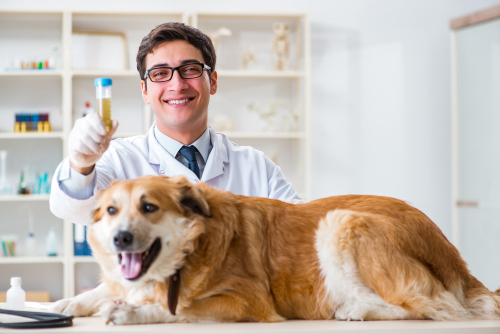
Why does a vet need to collect urine from my dog?
There are several reasons why a dog owner might need to collect urine from their pet. One reason might be to test for a urinary tract infection, a common condition in dogs. A urine sample can identify the presence of bacteria in the urine and help diagnose the illness.
Another reason for a urine test is to look for diabetes, as abnormal sugar levels in the urine can be an early sign of the disease. Additionally, newly developed urine tests are proving beneficial in identifying early signs of cancer in pets.
A final reason might be to test for kidney disease, as abnormal levels of certain urine substances can indicate kidney malfunction. Collecting a urine sample from a dog can be an important way to help diagnose and treat various health conditions.
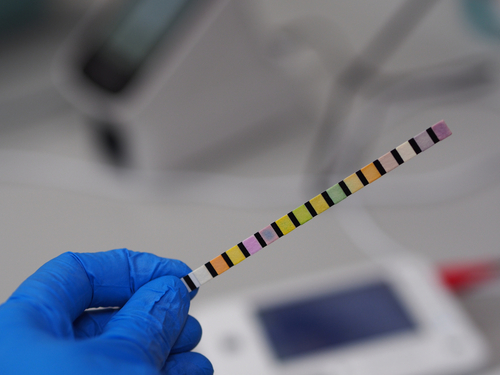
What is the canine urinalysis process?
A urinalysis is a type of lab test that can be used to diagnose and monitor health conditions in dogs. A veterinarian can use many different methods to collect a urine sample from a dog, including:
- the use of a particular container or bag that is designed to collect the sample
- the use of a syringe to extract the sample directly from the bladder
- the use of a needle to remove urine from the urethra.
Some veterinarians also use a pre-coated dipstick, which, when dipped into a urine sample, will change color in response to the presence of certain compounds. This process allows veterinarians to quickly and easily determine the presence of various elements in urine, such as blood, protein, glucose, and ketones.
Once the sample has been collected, the vet will send it to a lab for analysis. Using a microscope, lab technicians examine the urine sample in minute detail. The results can help identify even the most minor traces of blood or other abnormalities.
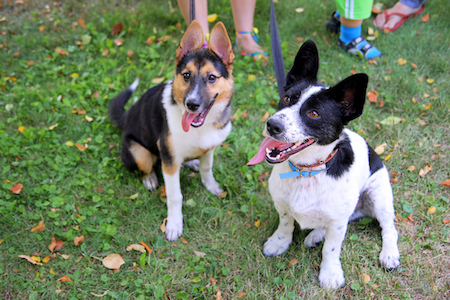
How can you collect urine from your pup?
Dog parents can collect urine from their pups in a few simple ways. Here are the steps to take to make this process easy for all involved.
Stay close and use a short leash.
One of the most important things to remember when collecting urine samples from your dog for testing is that you will need to be close by. If your pup is outside on a short leash, the leash makes it easier because she cannot move too far away from you.
Wear rubber gloves.
Wear rubber gloves to catch any samples, especially as you will probably have to maneuver close to your dog. Lifted legs and squats can cause splashing, leading to some direct contact. Remember to wash your hands thoroughly afterward.
Preparation depends on your dog’s peeing style.
Use a jar, plastic container, or small dish for leg-lifting dogs that is clean and preferably sterile. Place the item in the stream when your dog lifts his leg.
For squatting dogs, use a low-sided, flat container, such as an aluminum pie tin or plate. Slide the plate underneath your dog as soon as she begins to pee. You can also try to slip a deep spoon or ladle underneath your dog to collect the urine.
Most veterinary clinics will provide sterile containers for dog owners to capture or store urine samples. However, if your vet does not offer this option, use a clean plastic container with a lid that seals firmly.
Work with a partner.
You can make this process even easier by working with another person. Have your partner hold your dog’s leash while you sneak a urine sample from beside or behind your dog.
What about dogs with privacy issues?
Like most people, some dogs prefer privacy when they do their business. They may become nervous when their owner follows them closely around the yard to stick something underneath them.
If your dog needs space while peeing, take a stealthier approach to collect the urine. For example, try tying or taping a spoon or ladle to a yardstick or other long tool and placing it under your dog from a distance. Alternatively, you can use the yardstick to quietly push a pie tin or plate under your dog’s hindquarters.
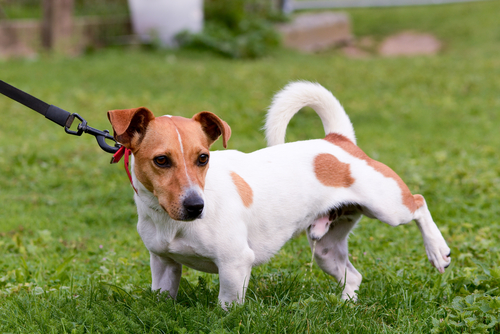
How can you train your dog for urine collection?
You can help your dog desensitize to the urine collection process with practice. Here are some tips to follow to get your pup accustomed to this action.
- Get your pup used to the container. Combine positive reinforcement while introducing your dog to whatever container you use for collection. Place the dish or tin alongside your dog’s food bowl, so she eventually gets used to seeing it frequently. Otherwise, your dog may be unpleasantly surprised to see a strange pie tin coming from nowhere when she goes to pee outside. You can also try pairing up the container introduction with tasty, high-value treats or gentle pets or scratches.
- Accompany your dog when she pees outside. You can help your dog get used to having you around when she goes potty. Instead of letting your dog out in the backyard by herself, go out with her. Your pup will become more comfortable with your presence during this activity. If necessary, go back to housetraining basics to establish a revised routine.
- Train your dog to pee on command. Once your dog is used to your presence when she goes to the bathroom, you can start teaching her to pee on command. This skill comes in handy when you need to collect a urine sample but don’t have a way to sneak up on your dog. To train this behavior, take your dog outside and give him the cue to “go potty.” When he does, immediately praise him and give him a treat. Your dog will learn to associate the signal with performing the desired behavior with enough practice.
Remember that accidents happen. If your dog has an accident inside or outside the designated potty area, do not punish him. Negative reinforcement will only make your dog more nervous about peeing in general.
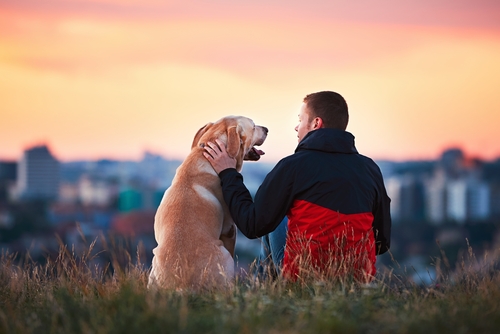
Conclusion for how to collect urine from your dog.
There are a few different ways that you can collect urine from your dog, depending on their individual needs. The most important thing is to make sure that you use a clean container and be as gentle as possible so as not to stress out your dog. With a bit of practice, you should be able to collect a urine sample from your pup to give to your vet without trouble.
Most pet insurance plans offer additional riders covering pets’ annual examinations, including urinalysis. Should your dog’s urine collection show evidence of a more significant medical problem, your policy will reimburse you for most of those exam and treatment costs. Protect your pet today with a pet insurance plan! Get your free quote through Pet Insurance Review now.
References:
Brower Wacholder, L. (2019). Urinary Tract Infections in Dogs. Retrieved from https://www.whole-dog-journal.com/health/bladder-uti/urinary-tract-infections-in-dogs/
Cain, E. (2022). Early Cancer Detection in Pets. Retrieved from https://www.petinsurancereview.com/blog/early-cancer-detection-in-pets
Martin, N. (2022). How To Collect A Urine Sample From Your Dog: Follow These Simple Tips. Retrieved from https://www.rover.com/blog/how-to-get-a-urine-sample-from-a-dog/
Kelley, T. (2022). How Often Do Dogs Need to Pee? A Vet Explains. Retrieved from https://www.dailypaws.com/dogs-puppies/health-care/how-often-do-dogs-need-to-pee
Cain, E. (2022). Housetraining a Puppy: Guides, Tips, Products & More. Retrieved from https://www.petinsurancereview.com/blog/house-training-a-puppy
Disclaimer
The information contained on this blog is intended for informational and educational purposes only and should not be construed as medical advice. It is not a substitute for professional veterinary care. Always consult with your veterinarian before making any changes to your pet's health care or treatment plan.
The authors of this blog are not veterinarians and do not claim to be experts in pet health. The information provided here is based on our own experiences and research, as well as information from reputable sources. However, we cannot guarantee the accuracy or completeness of this information.
We encourage you to do your own research and consult with your veterinarian before making any decisions about your pet's health.
Previous post
Dog Health Insurance: Is it Right for You?Next post
Why Do I Need Pet Insurance?Compare top pet insurance providers & plans.
Enter your dog’s age in years and months to calculate their age equivalent to human years.
Calculate your dog’s ageEnter your cat’s age in years and months to calculate their age equivalent to human years.
Calculate your cat’s age